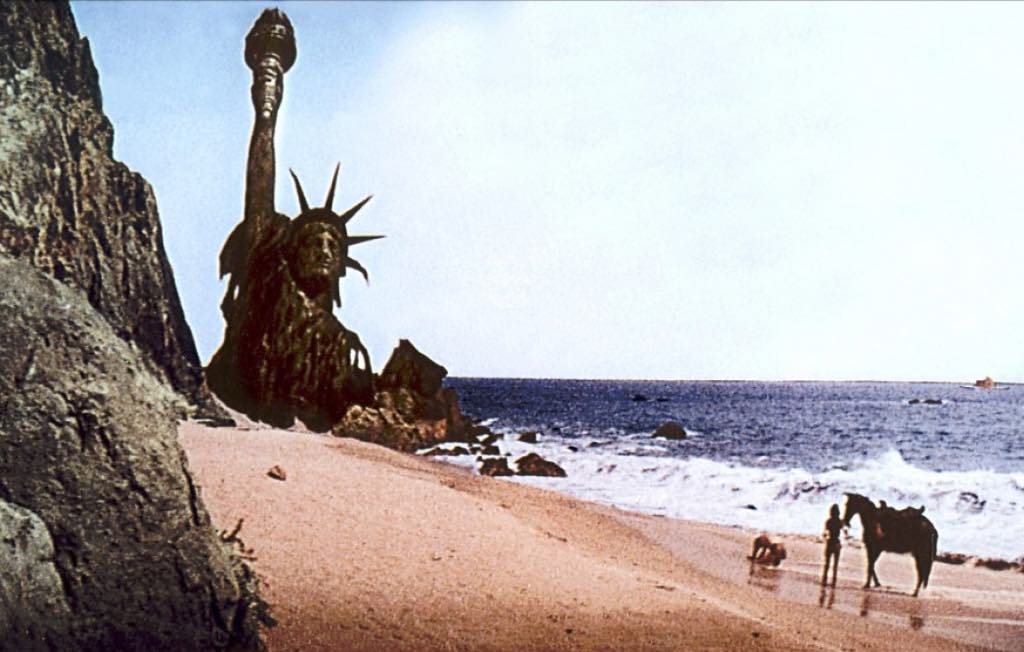
Planet of the Apes, probably the most successful sci-fi franchise after Star Wars, has permeated our culture with parodies and allusions, seen on everything from The Simpsons to the animated sci-fi film Rick and Morty. In 2018, Roseanne Barr infamously posted an offensive, career-ending tweet referencing the movies. It might come as a surprise, then, to learn that this seemingly quintessential American drama is based on a French novel, La Planète des Singes (1963) published in 1963 by Pierre Boulle. Most French speakers are unaware of it and are missing out on a thrilling work that ranks with Aldous Huxley’s Brave New World and George Orwell’s Nineteen-Eighty Four, though without the brand-name recognition of those two great 20th-century political fables.
Pierre Boulle (1912-94) is an intriguing figure. Originally from Avignon, he qualified as an engineer and worked in Malaya on British rubber plantations. When World War II broke out, Boulle worked for the French secret service and was eventually interned in a Japanese labor camp after narrowly escaping execution.
After the war, Boulle moved to Paris, where he became a writer, one of a long line of spies-turned-authors that includes Ian Fleming and Roald Dahl. Espionage evidently supplies plots, and Boulle’s experience of harsh captivity left its mark on him: his two best sellers, Le Pont de la Rivière Kwaï (The Bridge on the River Kwai, 1952) and La Planète des Singes both deal with the psychological effects of incarceration and collaboration. The two books were also made into box-office hits whose loose adaptations were a subsequent source of frustration to him.
The novel Planet of the Apes opens with a couple holidaying in a space vessel in a distant future in which such trips are commonplace. They stumble on a bottle floating in the void and retrieve it. The manuscript it contains describes the space mission of three French astronauts to Betelgeuse in the year 2500, the distant past. They find a habitable planet in the system, not dissimilar to Earth in climate and geography, but they are horrified to discover that this topsy-turvy world is ruled by primates, a hierarchical trio of chimpanzees, orangutans and gorillas, endowed with language and reason, whereas the humans, mute and bestial, are used by the apes as pets, for hunting or for scientific experiments.
The rest of the novel deals with the capture of the narrator, his integration into a research facility, his efforts to persuade his scientist-jailers that he is not like the other test subjects and the consequences of this turn of events for him and for the rest of the planet.
The central premise of the movie franchise – apes take over Earth following a nuclear war – is radically different from Boulle’s version, in which the action takes place in an alien world light-years away. The 1968 movie has one of the most iconic and memorable endings (written by Twilight Zone screenwriter Rod Serling) in cinematic history: a beleaguered Charlton Heston pounds his fists in the sand as the camera pans out to reveal a dilapidated Statue of Liberty on a beach. Instead of encountering another civilization in space, he has inadvertently traveled in time on his home planet.
Boulle’s gripping sci-fi novel fuses incorporates elements of detective fiction and presents an alien world that is neither a dystopia nor a utopia. The author plays with the reader: the narrator is not only unreliable at times but is also positively unlikable, in the lineage of morally dubious yet compelling literary narrators like Humbert Humbert in Nabokov’s Lolita (1955).
The narrator’s name is Ulysse Mérou, a sign of his paradoxical nature: Ulysses is the great mythological nautical hero, while in French, a mérou is a humble grouper fish. We accompany Ulysse in his struggle for freedom, but we can never quite root for him. Boulle adds a potent development into the mix: love. The narrator’s romantic feelings are disturbingly taboo; he has a Stockholm Syndrome-like attachment to Zira, a chimpanzee scientist who takes him under her (hirsute) wing as well as a troubling relationship with Nova, a human woman who has the equivalent IQ of a dog on Earth.
Nothing is black or white in this richly ambivalent tale with two shocking “twist” endings. The entire narrative is imbued with cynicism about human nature that one cannot help but feel comes from Boulle’s very soul. Capitalism is implicitly criticized throughout the novel for, as on Earth, consumerism and the dictates of a market economy prevail on the planet, confirming political theorist Fredric Jameson’s observation that “it is easier to imagine the end of the world than to imagine the end of capitalism” (Archaeologies of the Future, 2005).
A sign of the great influence of the film Planet of the Apes can be found on the cover of the latest French edition of Boulle’s book, which shows the ruins of the Statue of Liberty, something that was completely absent from the original novel. You’d be well-advised to overlook such monkeying around and just read this masterpiece!
